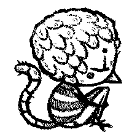Table of contents
Some notes as I study for my amateur basic radio license.
RADIO BASICS
- Atoms
- Current
- Voltage
- Conductors
- Tolerance
- Resistance
- Resistors
- Conductance
- Insulators
- Direct Current
- Cells and Batteries
- Circuit and Schematic Diagrams
- Alternating Current
Ohm's Law
- Resistors in Series/Parallel
- Voltage Drops
- Series and Parallel Resistor Combos
- Power
- Resistors and Power
Inductors and Capacitors
- Inductance
- Inductors
- Ac Inductors
- Inductors in Circuits
- Transformers
- Capacitance and Capacitors
- What Affects Capacitance
Units:
- C, Coulomb
- A, Ampere (calculated using ammeter)
- µA, Microamperes
- V, Voltage
- µV, Microvolts
- E, Potential difference (calculated using voltmeter)
- R, Resistance (calculated using ohmmeter)
- Ω, Omh
- kΩ, Kilohm
- W, Watts
- F, Farads
- H, Henries
- µF, Microfarads
Atoms
Atoms have a central core called a nucleus, which is positively charged, and which contains one or more particles called protons. Outside of the nucleus is mostly empty space, but it also houses negatively charged particles called electrons.
A neutral atom has equal positive and negative charge (same quantity of protons and electrons). If an atom gains electrons, it becomes positively charged, and if it loses some, it becomes negatively charged, and it is then referred to as an ion. When an atom loses or gains an electron/proton, this process is called ionization.
If an atom is under stress, say from heat, or by an electrical field, some of the outer shell electrons are dislodged. These are referred to as valence electrons, valence refers to the outer shell populated by electrons.
When current is run through something like a copper wire(a conductor), electrons move from one atom to another. Electric current is basically just a flow of electrons through a conductor.
Current
Current is measured in Coulomb(abbrev. as C). Note that this unit isn't based on one electron, but rather on a large group of electrons because the charge of a single electron is too small to be practical.
We measure current by the rate that electrons flow through a conductor per second, this is measured in Amperes(abbrev as A).
1 A equals 1 coulomb per second.
The symbol for current is I, appearing on electrical diagrams.
Ex: I = 5A, to say that the current is 5 amperes.
Current is measured with an ammeter, and can be expressed in:
Milliamperes (mA, or 1 thousandth of an ampere)
Microamperes (µA, a millionth of an ampere).
Current that goes in through a conductor, must come out. There are two ways to look at current flow:
Electron current. Where the current flows from negative to positive. Current flow is seen as excess electron entering a conductor, and pushing other electrons ahead of the line until one 'falls out'.
Conventional current. Where the current flows from positive to negative. Current flow is seen as an electron falling out at the end of a conductor, leaving a gap, making it so that neighboring electrons all shift one over to allow other electrons to enter at the other end. The gap left by the 'falling' electron makes it that the current flows in the other direction.
Both ways are used, these notes focus on electron current.
Voltage
Electrons on the outer shell(valence) are the ones easiest to move, held in their spot by electrostatic forces. When attempting to charge something, we're pushing electrons, which inevitably will be repelled by electrons that are already there, and by each other. The act of putting a charge to something by adding electrons, that 'effort' is measured in volts (abbrev. as V).
The effort needed to charge an object is a unit of work(a measure of energy transferred by electrons per unit charge), referred to as Potential Difference(abbrev. as p.d). P.D. means modifying a system such that the potential energy at point A is higher than at point B. The magnitude of a potential difference is equal to the work done on a particle if it moves between the two points. The p.d. is measured with a voltmeter, and represented in diagrams as E.
Ex: E = 12 volts
Small voltages are expressed in:
millivolts(mV, a thounsandth of a volt)
microvolts (µV, a millionth of a volt).
Conductors
Good conductors of electicity includes most metals, and some other materials. That a material is conductive means that it is easier to dislodge its valence electrons.
Good conductors, from best to worse: silver, copper, aluminum, and gold.
Non conductors(insulators): glass, porcelain, rubber, and some plastics.
Copper is the most widely used metal for conductors. Aluminum is used in long distance transmissions. Gold, not being the best metal conductor, is mostly used for its resistance to corrosion. Cost, application, mass and strength determined what metal is best in a particular situation.
Some metals don't conduct as well as others, there is opposition to the flow of electrons, and this creates heat. This reaction is referred to as resistance. Ex: wires in element of a heater. When making radio circuits, this heat is not desirable, there are ways to eliminate the heat that is generated (resistors, see later).
Tolerance
The values of components in electronics are only approximations. These values only need to be near to the marked value to function in a circuit.
The maximum permissible variation from the stated value is called tolerance. They're written as percentages of the marked value, they can be added or substracted from that value. How much variation depends on the application.
The larger the value of the variance, the lower the tolerance.
Ex: a resistor marked as 100 Ω with a tolerance of 10% may have a value of in the range of 100 ± 10%, or 90 Ω through 110 Ω.
Common tolerances are ±20%, ±10%, ±5%, and ±1%.
Resistance
All conductors oppose the flow of electrons to a point, this opposition is referred to as resistance. The unit of resistance is the omh, measured with an ohmmeter. Larger resistances are measured in kilohms and megohms.
Ohm's Law refers to how 1 Ω allows 1 ampere to flow when 1 volt is applied to a conductor.
How well a conductor conducts depends on:
- Resistance. Depends on material.
- Length. The resistance increases as the length of the conductor increases.
- Diameter. The resistance decreases as the diameter of a conductor increases.
- Temperature. The higher the temp, resistance increases and conductivity decreases.
Resistors
When electrons are forced through a conductor (esp certain metals), the metal is heated, and this is due to the resistance of the wire (not as easy to dislodge valence electrons).
Resistors are rated for a limited amount of heat, if exceeded they can burn up. This limit is measured in W (watts). The higher the wattage of a resistor, the more heat it can dissipate.
There are 3 kinds of resistors:
- Fixed resistors. Constant value of resistance.
- Tapped resistors. Has taps/connections along the length of the resistance element to divide it into a variety of resistances.
- Variable resistors. Has a moving slider/shaft that can change the resistance (like the volume control knob on old radios).
FIXED RESISTOR
Composition, has a thin film over a ceramic(or heat resisting) core. Carbon doesn't conduct well. The resistance is set by cutting spiral grooves in the carbon (serves to increase length of carbon). Outside is coated with an insulating coat. The coloured bands on a fixed resistor indicate the resistance (there are other types, wont list here).
Wirewound, Resistance wire is wound around an insulating material with space between the turns of the winding (then covered by an insulating coat).
TAPPED RESISTOR, like variable resistors where the slider is stuck.
VARIABLE RESISTOR
Wirewound, resistance wire is bound around a porcelain(or other strong insulated core) that can withstand a lot of heat. Contact is made via a slider, with every turn. Resistance can be set and tightened in place.
Composition, the most common type. The resistive element is baked on, and a 'rolling/wiping' contact traveling over the resistive element produces more or less resistance.
Color codes, composition resistors are too small for the resistance to be marked clearly, so instead it is indicated by series of colored bars. Every digit is assigned a color (10 in all).
Colour Value Tolerance Black 0 Brown 1 1% Red 2 2% Orange 3 Yellow 4 Green 5 0.5% Blue 6 0.25% Violet 7 0.1% Grey 8 White 9 Silver 0.01 10% Gold 0.1 5%
To remember the code, make up a phrase. In my study material I've encountered: Better Be Ready Or Your Great Ventures Goes West, but I think it best to make up your own. Mine is: Be Better Red, Or You'll Grow Beautiful Violet Grey Wings.
Hello, I am a resistor, and these are my bands.
-----[ |||| ]-----
ABCD
Band order also means something:
- Band A: First digit of resistance
- Band B: Second digit of resistance
- Band C: Multiplier, number of zeroes to add. If 3rd band is gold, multiply the number given by the two first bands by 0.1. If it's silver, multiply the number given by the first two bands by 0.01.
- Band D: If present, this gives tolerance of the resistor. If none present, tolerance is ± 20%
Ex: 470 Ω with a silver band, meaning it has a tolerance of ± 10%, the tolerance can be as high as 517 Ω, and as low as 423 Ω (470 ± 47, which is 10% of 470).
Conductance
In equations, conductance is abbreviated as G.
If a conductor has high conductance... it has low resistance
If a conductor has low conductance... it has high resistance
Insulators
Materials with such low conductivity that no current can run through them.
They're used to prevent wires from touching anything else (which can alter the current it is carrying).
Magnets
Magnets are used to manipulate current in electronics. The space around a magnet is a magnetic field, with invisible lines of force that flow from North to South, which are used to refer to the two polarities of a magnet (each side). The poles of a magnet repel each other, and opposites attract.
Lines of magnetic force
|------------------------------|
|-|--------------------------|-|
|-|-|-->[S magnet N]<--|-|-|
|-|--------------------------|-|
|------------------------------|
Electric current is made to flow through a conductor by:
- Moving a conductor through a magnetic field
- Moving the magnetic field around the conductor
- Moving both the conductor and the magnetic field
Note: This is how generators and alternators work. When the moving conductor is perpendicular to the lines of force of the magnetic field, the electric current is at its max.
There are 2 types of magnets:
- Permanent Magnets. One that doesn't change strength physically over time, made from iron, or steel alloys.
- Temporary Magnets. Which exist only when maintained by external forces (ex: electromagnet made of soft iron with a coil of wire around it).
Direct Current
With DC current, current flows in one direction only. There are 6 types of DC:
- Friction. Rubbing two surfaces together can knock off some of the valence electrons, causing current to flow.
- Heat. Applying heat to something can give electrons enough energy to escape an atom.
- Pressure. Some types of crystals, when subjected to pressure causes electrons to flow (piezoelectricity).
- Magnetism. Moving a conductor through a magnetic field, or a magnetic field through a conductor will cause electons to move (generators, alternators).
- Photo Electricity. Light striking the surface of some metals can dislodge electrons (ex: photo sensitive diodes).
- Chemical Action. Chemical energy turned into electrical energy (flash light cell).
- Electrostatic Field. An electrostatic field applied to the ends of a wire causes electrons to move.
Cells and Batteries
A cell(electrochemical cell) is something in which chemical energy is converted to electrical energy. Batteries are effectively, groups of cells connected together.
Each cell in a battery has two conductors called electrodes, which are immersed in an electrolyte. The interaction between the electrodes and the electrolyte creates a chemical reaction resulting in a flow of current.
B A T T E R Y
Neg Electrode Pos Electrode
| |
___ ___
----| |-----------| |----
| .| | . . . . | |. |
| .| - | . . . . | + |. |
| .| | . . . . | |. |
| .----- . . . . -----. |
-------------------------
Dots are electrolyte, a mix of water and substances
that separate into ions when dissolved.
Electrons flow from the negative electrode, to the positive electrode. The surface area of an electrode dictates the amount of current generated by the cell.
When connecting cells together to make a battery, they can either be connected in series, or in parallel.
Series. The positive terminal is connected to the negative terminal of the next cell, and thus the voltage increases. Ex: 2x6V batteries connected in series, equal one 12V battery.
Parallel. The positives are connected to the positives, and the negatives to the negatives. The voltage of a paralleled battery stays the same as one of the component cells.
There are primary cell and batteries in which cannot be reused when all of the chemical energy is consumed (zinc carbon cell), and secondary cell and batteries which can be recharged (storage batteries, lead acid etc).
Important characteristics of a battery:
- Shelf life. How long it'll stay usable when not in use.
- Internal Resistance. Limits how much current is available to use. When there is a load drawing a lot of current the voltage drops. As the cells age, or when the electrolyte dries out, internal resistance increases.
- Energy Capacity. A value of current delivered over a specific period of time, usually amperes hours (Ah) or milliampere hours (mAh). Exceeding the stated current can decrease the shelf life of the cell/battery.
- Cell Voltage. Dependent on the chemistry of the cell, electrodes and electrolyte.
Main cell types:
- Carbon-Zinc Cells. Cheap, available, useful for infrequent use, requires little current. Produces 1.5V when fresh.
- Alkaline Cells. A primary cell, long shelf life, allows for higher current, higher energy capacity. Produces 1.35V.
- Mercury Cells. A primary cell, more expensive, long working life, maintains rated voltage until it dies. Produces 1.4V.
- Nickel Cadmium Cells. Secondary cells, rechargable, hard to keep fully charged, very toxic mix (avoid).
- Lead-Acid Cells. Secondary cells, most commonly used, supplies high current, inexpensive for capacity, require care, very corrosive electrolyte, releases hydrogen gas (must be aired out). Produces 2.2V.
- Nickel-Metal Hybride Cells(NiMH). like Ni-Cads, but use hydrogen as active element instead of cadmium. Cell voltage is 1.2V
- Lithium Cells. Secondary cells. Variety of chemical compositions result in a range of voltages(2.1-2.4V).
Circuit and Schematic Diagrams
Terms:
- Closed Circuit. A complete circuit in which current can flow when a voltage is applied.
- Open circuit. A circuit with a break in the line, stopping the flow of current. Deliberate breaks include switches.
- Short Circuit. An abnormal connection betwween two points, resulting in some resistance, which can create a damaging flow of current.
Schematic Rules:
- Wires must be drawn as straight lines.
- Each component is represented by a symbol.
- The position of a symbol is not important (vertical, horizontal).
- Input ought to be at the top left, and output at the bottom right.
- Power supply wiring may not be drawn in, but can be referenced by labelled terminals or a chart.
AC
Alternating current bears its name well, as current travels one way and then the other. This reversal is counted and referred to as frequency. If living on land, house current is 60 hertz, meaning that it reverses 60 times per second. 1 hertz = 1 cycle/per second. In a cycle, the current rises to a high point in each direction and a return to zero.
In-Phase: Waves of the same frequency as 'in-phased' when the voltage and current rising at the same time, both starting at zero and reaching the maximum point together.
If measured these intervals using an oscilloscope, a sinewave would appear. The transition between pos and neg voltage and current isn't abrupt (doesn't draw sharp edges) but instead creates smooth curves.
For AC voltage to be converted to DC, the peak voltage must be 1.414 times that of DC. RMS or root mean square, is an AC voltage equivalent of DC.
Ohm's Law
Ohm's Law refers to the fact that voltage(E) is equal to current(I) multipled by the resistance(R).
E = I X R
Using this formula as a base, it's possible to find the value of the others: I = E / R, or R = E / I.
Ohm's Law Pyramid
.
/ \
/ E \
-------
/ I | R \
-----------
Using base values. When using Ohm's Law, all voltages expressed in millivolts, microvolts, and kilovolts have to be converted to volts. Current in milliamps and microamps have to be expressed in amperes. Resistance in kilohms and megohms must be expressed in ohms.
Ex: 12 V battery with a 25 ohm resistor, what is the amperage of this circuit? E / R = I And so 12 / 25 = 0.48 amperes
An example that includes converting to base values:
Ex: A circuit with 30 mV and a resistance of 30 kΩ, what is the voltage? We must convert the units from: - millivolt to volt - kilomhs to ohms 30 / 1000 30 mV is 0.030 V 30 x 1000 30 kΩ is 30,000 ohms E / R = I, so 0.030 / 30,000 = 0.000001 A, or 1 µA
Resistors in series/parallel
In a circuit, there can be multiple resistors connected either in series, or in parallel.
Series:
- The total resistance is the sum of the resistances in the circuit, always greater than any individual resistances. R = R1+R2+R3+...
- The total voltage across the circuit is the sum of all voltage drops across all resistors. E=E1+E2+E3...
- The current is the same through each resistor and is the same total current of the circuit. I = I1 = I2 = I3...
Parallel:
- Total resistance is calculated using 1/R(total) = 1/R1 + 1/R2 + 1/R3...
- The voltage across each resistor is the same and equals the applied voltage. E(total) = E1 = E2...
- Total current is the sum of all individual currents. I(total) = I1+I2+I3...
- The total resistance in a parallel circuit is always less than any individual resistances.
Rules for parallel resistors:
R1xR2
R (total) = _______
R1+R2
An example using the above formula for parallel resistors:
Two parallel resistors. R1 has a value of 1000 Ω R2 has a value of 2500 Ω The total resistance would be... Calculations: 1000x2500 = 2,500,000 1000+2500 = 3,500 2,500,000 / 3,500 = 714 Ω The total resistance would be 714 Ω.
If there are 3 resistors, calculate the total resistance of R1 and R2 for the formula for two parallel resistors. Then, take that value, and using that same formula again with R3. See example:
Three parallel resistors.
R1 has a value of 1000 Ω
R2 has a value of 2500 Ω
R3 has a value of 500 Ω
The total resistance would be...
Calculations for R1 and R2:
1000x2500 = 2,500,000
1000+2500 = 3,500
2,500,000 / 3,500 = 714 Ω
Then, using the combined value of R1 and R2 in the same equation with R3...
R(1+2)xR3
R (total) = _______
R(1+2)+R3
714x500 = 357,000
714+500 = 1,214
357,000 / 1,214 = 294 Ω
When all resistors in a circuit are of the same value, the total resistance is R(total) = R / N(the number of resistors in the circuit). If the circuit has three 1000 Ω resistors, the total resistance would be 1000 / 3 = 333 Ω.
Voltage Drops
Adding resistors in a circuit drops the current, how much depends on the size and the quantity of resistors. To measure the voltage drop between two points, we use Ohm's Law.
r1 = 3r
r2= 9r
2A current flow
--------------.---- A
| |
| r1
+|- |
| .---- B
| |
| r2
| |
|__switch_____.------C
To find voltage across r2:
I2 x r2 = E2
2 x 9 = 18V
(which is the voltage drop between B and C)
To find voltage drop between A and B
I2 x r1 = E1
2 x 3 = 6V
The total applied voltage from the battery is found by
adding the voltage across the two resistors:
E1 + E2 = Etotal
6 + 18 = 24 V
Series and Parallel resistor combos
Circuits can contain both resistors in series and in parallel.
If a circuit has R2(60) and R3(40) in series, and R1(100) in parallel...
R2 + R3 = Total Ω
60 + 40 = 100 Ω
R1 x R(2+3)
---------- = Total Ω
R1 + R(2+3)
100 x 100
--------- = 50 Ω
100 + 100
If a circuit has R2(20) and R3(30) in parallel, and R1(100) in series...
R2 x R3
---------- = Total Ω
R2 + R3
20 x 30
--------- = 12 Ω
20 + 30
Total resistance would be:
R(2+3) + R1 = Total Ω
12 + 100 = 112 Ω
Power
A battery is like a stretched spring, storing energy until it is used. When a battery isconnected to something through which electrons can flow, it is said to be 'working'. The rate at which work is done is called power, and the unit used to measure it is the watt (using a wattmeter).
If we know two values, either the voltage, current or resistance, the others can be found.
If a circuit is 12V, drawing 5A, the voltage(power) is... E x I = P 12 x 5 = 60 W
If a 470 Ω resistor is rated at 1/2 W max power dissipation, the maximum voltage and max current limits can be found like this:
First, calculate voltage...
P x R = E2
0.5 x 470 = 235V
Then, using square root of a calculator...
√235 ≈ 15 V
To find the current...
P / R = I2
0.5 / 470 = 0.00106
I = √0.00106
= 0.033 A, or 33 mA
Resistors and Power
In a circuit, if a calculation proves that a 1/2 W resistor is required, add a margin of safety by adding a resistor that has a power rating 50-100% greater than this. In this case, using a 1 W resistor is better.
When a circuit has resistors in series, the heat of each must be calculated separately because the same current flows through all.
INDUCTORS AND CAPACITORS
Inductance
A straight conductor carrying a steady current produces a magnetic field around it, its strength depends on current flow. If there is more current, the stronger the magnetic field will be.
In AC, the current doesn't just flow in one direction, the magnetic fields an AC conductor produces are constantly changing and can even interfere with themselves. The direction of current flow affects the direction of a magnetic field.
Current flowing from negative to positive will generate a magnetic field that turns clockwise. A trick to remember the direction is place your left hand on a wire with the thumb pointing in the direction of electron flow from neg to pos, curling your fingers will indicate the direction of the magnetic field, the tips of the fingers indicate this.
Current through a straight conductor won't be as strong as one through a coil or spiral, even with higher current. If a magnetic material is inserted in the center of a spiral or coil, it concentrates the magnetic field. The winding direction of a coil, and the direction of current flow affects the direction of the magnetic field.
Inductor. When a circuit is turned on, current flows through the conductor but takes a while for the magnetic field to be created, then it reaches it stabilizes and the current reaches its max value. When the circuit is turned off, the magnetic field collapses and the current flows in the opposite direction, induced in the conductor. "This action can be compared to how a flywheel works, in that it takes time to get up to speed, and that continues to rotate even after power has been turned off."
The magnetic in and around an inductor is affected by:
- The strength of the current
- The more turns in a coil the stronger the magnetic field
- The longer the coils the more total turns, creating a stronger magnetic field
- The smaller the diameter of a coil, the stonger the current
- The permeability of a core, certain core materials provide better path for the magnetic lines of force (as opposed to air, which has permeability value of 1)
Inductors
Inductors make use of the energy stored in a magnetic field, they're said to have inductance. The unit of inductance is the henry, H, nanohenries (nH), hundred henries. The electronic abbreviation for inductance is L.
Core materials: low AC frequencies(60Hz) use laminated steel. In radio cores are made from different types of ferrite (powdered iron suspended in a plastic/ceramic filler). UHF and VHF use air, but some VHF use aluminum.
Types of inductors:
- Solenoid-wound, air core inductors (used in antenna tuners)
- Toroid core wound inductor, contains magnetic field in a small volume of space, doesn't require shielding
- Adjustable inductors, inductance is adjusted by moving the core in and out of the inductor
- Fixed inductors, has multiple windings, big
If the core of an adjustable inductor is powdered iron, the inductance decreases increases when the core is inserted, if it's aluminum, the inductance will decrease.
Back EMF. When a magnetic field collapses, a voltage is produced. Its magnitude depends on the rate at which the magnetic field is changing. The inductance of a coil is 1 H when current through it changes at a rate of 1 A per second produces a back EMF of 1 V (sorry, what...).
AC in Inductors
The nature of AC, with current flowing in one direction and then the other, the magnetic field in an AC inductor increases in size and collapses as the current flow increases/decreases. The conductor is cut by its own changing magnetic field, and thus a back EMF is induced. This is called Self Inductance. Self inductance increases if a conductor is wound in a coil.
Back EMF relies on a change of current, characteristic to AC (of little consequence with DC).
Inductors in Circuits
(solid) (dotted) (no line)
iron core special core simple core
| | |
)| )| )
)| ) )
)| ) )
)| )| )
| | |
Varying the inductance of a coil is essential to tuning circuits. Changing the number of turns is accomplished by:
- Using a rolling contact, allowing the inductance to vary continuously. Roller/rotary conductor.
- Tapping the coil at various points, permanently(soldered) of temporarily(alligator clip).
- Installing a shorting switch that shorts out sections of the coil
- Changing permeability of the core (moving in/out)
Transformers
Mutual inductance. When changing current in one inductor induces a current in another inductor.
Coaxial coils are wound around the other and create the greatest mutual inductance. If the coils are at right angles to each other, they have the least inductance.
In a transformer, AC current flows in one coil (primary), and induces a flow of current in another coil (secondary) by proximity. The induced secondary current flows in the opposite direction. How much voltage is induced in the secondary depends on the number of turns in the primary coil. If both coils have the same number, the voltage will be the same. If either coil has more turns than the other, the voltage will be proportionately higher.
Es = Ns __ __ Ep Np Es: voltage induced in secondary Ep: voltage across primary Ns: number of turns in secondary Np: number of turns in primary
Step up transformer. If number of turns in secondary > number of turns in primary = voltage in secondary > greater than voltage in primary.
Step down transformer. If number of turns in primary > number of turns in secondary = voltage in seconday < than voltage in primary.
One to one transformer. When primary + secondary have same number of turns.
If AC voltage of 150 AC applied to primary with turn ratio of 5 to 2. There are 120 turns in primary. What is secondary voltage and number of turns in secondary coil.
Information breakdown:
Ep= 150 VAC
Np= 120 turns
Ns= 5 (ratio)
Np= 2 (ratio)
Calculating number of turns in the secondary...
Ns 5
__ + __
120 2
120x5
_____ = 300 turns (Ns)
2
Calculating the voltage of the secondary...
Es = Ns Es = 300
__ __ | __ __
Ep Np 150 120
300x150
_______ = 375 V (Es)
120
Magnetizing Current. If the secondary has no load when the circuit is open, no current will be induced by the primary but current will flow though the primary.
Transformers...
- Isolate part of a circuit from another, no conductive link, only magnetic between secondary and primary(one to one transformer). It doesn't change the voltage.
- Raise/lower voltages
- Match impendance
Transformers aren't perfect, they get warm and some energy is lost. The causes of energy loss are:
- Eddy currents. When the magnetic field changes, eddy currents are induced in the core which causes it to heat up.
- Winding resistance. Windings are conductors (copper) and there is a bit of resistance (copper loss).
- Magnetic leakage. It's difficult to ensure that not all magnetic lines of forced produced by the primary cut the wires of the secondary.
- Hysteresis. Iron cores becomes magnetized during each AC cycle and must demagnetize at the start of next cycle (hysteresis loss).
Capacitance and Capacitors
A capacitor stores electrical energy. Capacitance refers to a capacitor's ability to store electrical charge. The unit of capacitance is the Farad (F abbrev, and C in formulas)
Capacitors consist of two plates made from conductive materials, separated by an insulating material called the dielectric. When there is voltage across a capacitor, an electrostatic field builds up between the two plates, in the dielectric. A charged capacitor will have the same voltage as the battery. The charge stays on the plates for some time, but eventually decrease due to leakage.
When charging a capacitor from a battery, electrons flow from the negative side of the battery to the negative plates of the capacitor, and accumulate there. Electrons on the other plate are repelled by the accumulation of electrons on the neighboring plate and are driven back, which leaves the plate positive(electron deficient).
Dialectric materials include: ceramic, polycarbonate, polyester, Mylar, tantalum, etc.
Variable Capacitors: they can change the effective areas of the plates, or the spacing, to control the capacitance of a circuit.
Air Variable Capacitors: they have a rotary shaft which can adjust two sets of plates so that they overlap, the capacitance depends on the position of the shaft.
Compression Trimmer Capacitors: Capacitance is changed by compressing of loosening a screw which separates the plates or brings them closer together.
Vacuum Variable Capacitor: A capacitor enclosed in a vacuum container. In the absence of air, higher voltages can be sustained w/o the charge jumping from one plate to the other.
Electrolytic Capacitors: They have a specific polarity, either pos or neg and have to be connected accordingly. The dielectric is produced by an electrochemical reaction in the capacitor to produce big capacitance in a small package.
What Affects Capacitance
The effective area of the plates. The larger the plates(or adding more plates), the more energy can be stored. A larger capacitor will require more charge.
Distance between plates. If the plates are moved closer together, the electrons on the opposing plate are repelled at greater intensity, there is more charge flow, capacitance thusly increases. Capacitance decreases if the plates are moved apart.
Dialectic Material. Some materials offer better capacitance for the same plate area and spacing.
Capacitors Series/Parallel
Unlike the calculations for resistors and inductors in series or parallel, capacitors use the opposite formula.
For parallel, total capacitance is the sum of all capacitors, for series total capacitance is calculated like:
C1 x C2
Total Capacitance = _______
C1 + C2
When connected in series the total capacitance of the circuit is less than the capacitance of the smallest capacitor.
Working Voltage
All capacitors have a working voltage, expressed in VDC, and it is the maximum voltage that the capacitor can sustain continuously w/o leaking excessively, or breaking down.
Reactance
Reactance is the opposition to the flow of AC, it is expressed in Ohms. There is no energy dissipated in a reactance, and the energy always returns to the circuit.
Inductive Reactance. The opposition to the flow of AC by an inductor.
As the inductance increases in a circuit, so does the inductive reactance. As it decreases, the inductive reactance too decreases.
As the frequency of AC increases so does the inductive reactance. As it decreases, the inductive reactance too decreases (ex: AC at 60Hz will have less opposition from an inductor than AC at 400 Hz).
Inductive Reactance (X) = 2πfL
X = Inductance Reacted in Ohms
π = 3.14
f = Frequency in Hz
L = Inductance in henries
Capacitive Reactance. The opposition to the flow of AC by capacitance (when in each AC cycle the energy returns to the circuit, it opposes AC current flow). It is measured in Ohms.
1
Capacitive Reactance (X) = ____
2πfC
X = Inductance Reacted in Ohms
π = 3.14
f = Frequency in Hz
L = Capacitance in farads
As the capacitance increases in a circuit, the capatitive reactance is decreased. As it decreases, the capacitive reactance increases.
As the frequency of AC increases the capacitive reactance decreases. As it decreases, the capacitive reactance increases (ex: AC at 60Hz will have less opposition from an inductor than AC at 400 Hz).
Impedance
When a circuit has both resistance and reactance, the circuit is then call impendance.
Impedance(Z) is a measure of the extent to which a circuit opposes the flow of electricity. All materials have some degree of electrical resistance, which causes some energy to be lost as heat, and reduces the flow of current. In a DC circuit, impedance is the same as resistance, in AC there is also reactance (capative and inductive).
Impedance in a series circuit is calculated using:
R = Total series resistance
X = Total reactance
Z = √ R2+ X2
Impedance Matching. Means that there is a maximum transfer of power between two devices if the circuit to which the input is connected has same impedance(Omhs) as the input circuit, and if the circuit to which the output is connected has the same impedance as the device it feeds into.
A low impedance circuit shouldn't be connected to one that is high, and vice versa.
If connecting a TV system with the follow components... Coaxial cable = 75 Ohm (Zp) TV twin lead = 300 Ohm (Zs) A transformer is used to match them up. To calculate the turns ratio: Zs = Impedance secondary Zp = Impedance primary Ns = Number of turns seconday Np = Number of turns primary Formula: √ Zs Ns __ = __ Zp Np √ 300 4 __ = __ = 2 (revisit this...) 75 1
Resonance
Resonance occurs when the inductive reactance in a circuit is equal to the capacitive reactance, they cancel each other out.
formula for resonance:
Fr = Resonant frequency in Hz
π = 3.14
L = Inductance in henries
C = Capacitance in farads
1
Fr = ____
2π√LC
Tuned Circuits
Tuned circuits are referred to as RLC circuits (r=resistance, l=inductor, c=capacitor). Tuning a circuit refers to two things:
Varying the frequency. Consider a circuit that has a capacitor and inductor, each with a fixed value, and that an AC signal is introduced. We can vary the frequency of the AC, starting say at 0 Hz and increasing it. According to the rules of reactance and capacitance, inductive reactance will increase as the frequency of AC increases, while the capacitive reactance will decrease as the frequency increases. At one point, the resonance of the two will match up.
Varying inductance or capacitance(or both).. If a circuit is equipped with a variable inductor, capacitor, or both, we can inject an AC signal of fixed frequency.
When a circuit is resonant, there is minimum loss.
EX: when tuning a radio to listen to a specific frequency, we are tuning the selective circuits in it to resonance to the desired frequency (the channel we want to listen to).
Series RLC circuit. Used to select one frequency from all others.
Parallel RLC circuit. Used to reject a specific frequency and pass all the others.
Q
Q Factor, or Quality Factor, determines how effective a tuned circuit will be in selecting only a select band of frequencies.
When a circuit is resonant, the energy is stored in both the electric field of the capacitor and then in the magnetic field of the inductor. The result is that the current running through the wires, inductor's coil and the plates of the capacitor.
Resistance in a circuit removes some of the energy from a resonant circuit, and it has the effect of broadening the band of frequencies selected by the resonant circuit.
Anything that removes energy from a resonant circuit reduces the Q.
Waves and Bands
Waves: Amplitudes
Amplitude can be seen as ocean waves, in which the difference between the crest and trough of the wave is used to illustrate how wavelengths work. The bigger the difference between the crest and trough, the bigger the amplitude.
Waves: Frequency
Frequency can be illustrated too with ocean waves. Say you have eyes fixed on a specific point in the horizon, and that you count up the waves passing that point in a fixed amount of time, this is a good way to visualize frequency. Frequency is the number of complete cycles, or waves, per second. A complete 'wave' would refer to a measurement from a fixed point on the wave, to the same point on the next wave.
Cycles per second are expressed in hertz (Hz). 1 Hz is one complete cycle/wave per second.
The same wave submitted to a different frequency will alter the number of waves in the same amount of time. A wave with a frequency of 7 Hz per second can seen as 7 waves passing in one second, while a wave with a frequency of 1 Hz will less one wave pass per second.
7 Hz per second (7 waves per second)
^ ^ ^ ^ ^ ^ ^
/ \/ \/ \/ \/ \/ \/ \
1 Hz per second (1 waves per second)
^
/ \/
Waves: Wavelength
The distance one wave(or one cycle) takes to travel point A to point B is referred to as a wavelength. A wavelength is measured in metre(m). The symbol used for wavelength is the lambda.
A higher frequency wave will have a shorter wavelength, and a lower frequency wave will have a longer wavelength.
Oscilloscopes are used to visualize waves.
Electromagnetic Waves
Electromagnetic waves (EM for short) are a means of transferring energy, for this kind of energy to be transferred a medium is needed to carry them.
This type of wave is sent out at the speed of light(300 million metres per second). All waves on the electromagnetic spectrum (radio, light...) don't vary their speed, they remain constant.
Frequency and wavelength are inversely related to each other. As frequency increases, wavelength decreases in proportion. As the frequency decreases, the wavelength increases.
Radiowaves are between the electromagnetic spectrum ranging from 3 kHz to 3 000 GHz. The frequencies in radio are expressed in megahertz, and wavelengths in metres.
The formulas (2 variations) relating frequency and wavelength:
f = frequency
lambda = wavelength in metres
300
f = _____ MHz
lambda
or
300
lambda = ___ M
f
What is the frequency of an 80 metre Amateur Band?
300 300
f = ___ = ___ = 3.75 MHz
lambda 80
What's the wavelength of a station that emits on 146.5 MHz?
300 300
lambda = ___ = _____ = 2.05 M
f 146.5
 About
About Projects
Projects Books
Books Games
Games Stories
Stories Store
Store Notes
Notes How-to
How-to